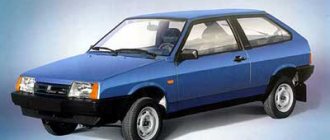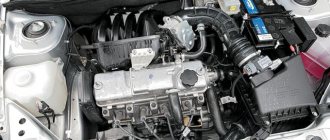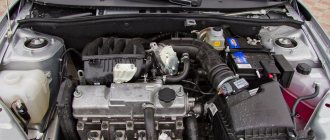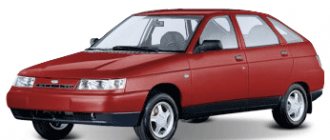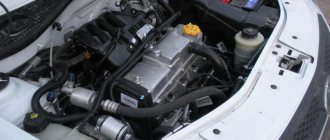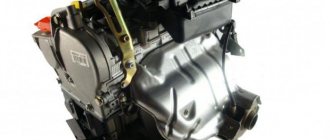At the end of the 70s, the domestic automobile industry needed a front-wheel drive car. None of the engine designs available at that time were suitable for this; AvtoVAZ management entered into an agreement with Porsche to design an engine for a 5-speed manual transmission.
ICE 2108
The VAZ 2108 engine received a volume of 1.3 liters, a transverse arrangement under the hood, a reduced coefficient of resistance to movement and a “swinging candle” type suspension.
Characteristics of ICE 2108
German designers built a small amount of power into the engine, sufficient for a three-door hatchback weighing less than 1 ton. The timing drive again became a belt drive, but the shortcomings of the previous generation 2105 were taken into account. The existing cooling system was ideal for a small engine; replacing it was not practical in terms of cost.
Timing belt drive
ICE 2108 has advanced technical characteristics for its time:
| Manufacturer | VAZ |
| Engine brand | VAZ-2108 |
| Years of production | 1984 – 2004 |
| Volume | 1.3 l |
| Power | 47.2 kW (64 hp) |
| Torque | 95 Nm (3400 rpm) |
| Weight | 127 kg |
| Compression ratio | 9,9 |
| Nutrition | carburetor Solex 1107010 two-chamber emulsion mechanical (cable drive) |
| Motor type | in-line |
| Number of cylinders | 4 |
| Location of the first cylinder | near the timing chain |
| Number of valves on each cylinder | 2 |
| Cylinder head material | aluminum alloy |
| Allowable warpage | manifold gaskets (intake/exhaust) 0.08 mm, cylinder head gasket 0.05 mm |
| Valve seat | width 2 mm, angle 45° |
| Camshaft | one upper cylinder head inside, phase width 232°, exhaust valve advance 42°, intake valve lag 40° |
| Camshaft oil seal | diameters – 40 mm, 56 mm, width 7 mm |
| Cylinder block material | cast iron |
| Cylinder diameter | class A – 76 – 76.01 mm class B – 76.01 – 76.02 mm class C – 76.02 – 76.03 mm class D – 76.03 – 76.04 mm class E – 76.04 – 76.05 mm |
| Pistons and rings | piston made of aluminum alloy, cast iron rings, compression rings - chrome plated on the outside (top) and beveled (bottom) |
| Piston diameter | class A – 75.94 – 75.95 mm class C – 75.96 – 75.97 mm class E – 75.98 – 75.99 mm |
| Gaps | piston/cylinder wall – 0.153 – 0.173 mm (standard) or 0.19 mm (maximum) piston rings – 110 mm relative to the cut plane |
| Upper compression ring | 1.535 – 1.555 mm |
| Lower compression ring | 3.957 – 3.977 mm |
| Oil scraper ring | 2.015 – 2.035 mm |
| Gap between piston groove and ring | 0.04 – 0.07 mm (compression lower) 0.02 – 0.055 mm (oil scraper) 0.03 – 0.06 mm (compression upper) |
| Crankshaft | cast iron, casting |
| Number of main bearings | 5 |
| Gearbox neck diameter | 50.799 – 50.019 mm |
| Main journal gap | 0.1 – 0.5 mm |
| Connecting rod bearings | shaft journal diameter – 47.83 mm liner thickness – 1.448 mm liner width – 28.025 – 28.975 mm |
| Crankshaft oil seals | front – diameters 42 mm, 60 mm, width 7 mm rear – diameters 85 mm, 105 mm, width 10 mm |
| Piston stroke | 71 mm |
| Fuel | AI-92 (A-76 allowed) |
| Environmental standards | Euro 2 |
| Fuel consumption | highway – 7 l/100 km combined cycle 8.2 l/100 km city – 10 l/100 km |
| Oil consumption | maximum 0.7 l/1000 km |
| Engine oil for 2108 | 5W-30 and 15W-40 |
| Engine oil volume | 3.5 l |
| Replacement frequency | every 15,000 km |
| Working temperature | 80° |
| Motor life | declared 120,000 km actual 200,000 km |
| Adjustment of valves | washers |
| Cooling system | forced, antifreeze-A40M, Spectrol |
| Coolant quantity | 7.3 l |
| water pump | polymer impeller, mounted on a block |
| Ignition | non-contact, switch, coil, commutator and distribution sensor |
| Candles for 2108 | Thread M14x1.25 mm, thread length 19 mm, glow number 17 A17DVR |
| Gap between spark plug electrodes | 0.7 – 0.8 mm |
| Timing belt | 111 teeth |
| Cylinder operating order | 1-3-4-2 |
| Air filter | dry with replaceable cardboard cartridge and pre-cleaner, temperature adjustment according to the season |
| Oil filter | recommended Mann W914/2 |
| Flywheel | 129 teeth, 0.62 kg internal hole diameter – 25.67 mm outer diameter – 27.75 mm number of mounting holes – 6 pieces no offsets |
| Flywheel mounting bolts | M10x1.25 mm, length 23.5 mm |
| Valve stem seals | Manufacturers Horse or Corteco |
| Compression | pressure in the cylinders from 11 – 14 bar, pressure difference in individual cylinders within 1 bar |
| Oil temperature | 80°С |
| Thermostat temperature | 80 – 84°С |
| Valve pressure inside the radiator cap | 0.7 – 1 bar |
| Content of harmful products in the exhaust | CH <200%, CO <3% |
| XX speed | 600 – 700 min-1 |
| Tightening force of threaded connections | spark plug – 31 – 39 Nm flywheel – 62 – 87 Nm clutch bolt – 19 – 31 Nm bearing cap – 69 – 84 Nm (main) and 44 – 54 Nm (connecting rod) cylinder head – 4 stages 20 Nm, 71 Nm + 90° + 90° |
The manufacturer recommends using exclusively the given parameters for clearances and tightening forces of threaded connections. It is indicated which oil to pour into the engine and lubrication system.
Transverse motor installation
A distinctive feature of the 2108 internal combustion engine is the fact that, taking into account several repair sizes of the cylinder bore and the piston/ring repair kit, it is classified as a “million-dollar” engine.
LADA Victory [edit | edit code]
The difference from the base model was that Victory was a four-wheel drive (4x4) vehicle. LADA Victory was created by adding a transmission, in particular an angular gearbox, a viscous coupling of the VAZ 21099 model and a Volkswagen Golf Syncro rear axle gearbox. The axle shafts remained from the base model, one transmits torque from the engine to the rear axle, and two more serve to drive the front wheels. The exterior of the Victory differed from the basic modifications of the VAZ 21099 by a rear spoiler; the car was equipped with alloy, fourteen (14″) inch sports wheels and bright red “Victory” and “4×4” nameplates on the trunk lid.
The exhaust system was also changed on Victory, and the engine was installed with a volume of 1600 cm². Speaking about the technical characteristics of the car, we can note the good acceleration dynamics of the Victory, which is not surprising, because the engine was installed with a boost [7].
All-wheel drive provided the car with simply amazing maneuverability, but due to its cost, the VAZ 21099 Victory was not widely used, and production of the car was curtailed. The car was also exported to countries in Europe, Asia, Africa, North and South America. [ source not specified 154 days
]
Pros and cons
Taking into account the characteristics of the engine, in particular the small volume of 1.3 liters, immediately after launch into production the following shortcomings were revealed:
- leaks through the block cover gasket - the error has not been corrected;
- Solex carburetor - required frequent adjustment of the idle modes;
- pump - intensive wear of polymer blades.
Carburetor for 2108
Since the 2108 engine was the first with a transverse arrangement under the hood of a car, the default exhaust manifold changed its design in comparison with previous generations of AvtoVAZ internal combustion engines. However, the intake manifold remained the same.
Reliability, weaknesses, maintainability
Reliability
During factory tests, the VAZ-2108, and later in wide operation, proved to be reliable and economical, stable in operation. High-quality assembly, the use of reliable components and parts is confirmed by the fact that the units of early releases operate reliably to this day.
At various specialized forums, car owners share their impressions of the engine. The vast majority of reviews are positive.
For example, Vladimir from Krasnodar writes the following: “... over 23 years of operation, it has traveled more than 500,000 km and is now on the move. On the negative side: oil was leaking from under the timing cover and I had to change the heater radiators and cooling system - I filled it with low-quality antifreeze...”
Den from the Zaporozhye region speaks of his long-liver as follows: “... the engine has never had major overhauls (but the rings and pistons have been changed), the condition of the cylinder walls is ideal, the fuel consumption is frankly pleasing, although the car is 22 years old...”.
All car owners, without exception, emphasize the importance of timely and quality service. And they emphasize that only in this case the engine will serve flawlessly.
Dmitry from Moscow says on this topic: “... mileage 175,000 km, starts with half a turn. The car never failed. I would like to give advice to respected car enthusiasts: if you want your iron comrade to serve you faithfully for many years, treat it with respect...”
Reliability is convincingly demonstrated by the fact that the resource declared by the manufacturer is exceeded by more than three times.
The safety margin indicator is of no small importance.
Tuning VAZ-2108
The engine can be boosted to 200 hp. With. True, to the detriment of the resource. Here it’s not for everybody – either the original engine will last for a long time, or a particularly powerful one, but for a short time.
Thus, the reliability of the VAZ-2108 is beyond doubt.
Weak spots
Immediately after leaving the assembly line, car owners discovered several weak new engines.
- The valve cover required modification because its gasket often failed.
- A low resource of the cooling system components was noted. Particularly annoying were the water pump and connecting hoses, which required frequent replacement.
- Engine detonation. The reason for its occurrence was low-quality fuel. The slightest deviation in this matter, in addition to detonation, caused clogging of the carburetor.
- The Solex carburetor turned out to be quite capricious in operation. Particularly annoying was the need to frequently adjust the idle speed and clean it. Subsequently, the Solex was replaced by a more efficient Ozone carburetor.
The occurrence of other problems was a periodic occurrence. Almost all of them are directly or indirectly related to violations by the car owner.
For example, leakage of oil or coolant from under the seals. It is enough to detect the malfunction in time and fix it immediately. Or loud engine operation. The phenomenon is unpleasant, but it is enough to adjust the valves or set the ignition and the problem disappears. Often, saving on fuel (low-octane refueling) contributed to the appearance of detonation, and therefore unnecessary noise.
Overheating of the engine could be caused by a faulty thermostat or electric fan of the cooling system. In the case of constant monitoring of the operating temperature of the internal combustion engine by the driver, engine overheating is excluded.
Despite the existing shortcomings, we can conclude that they do not exceed the critical threshold in comparison with the motors previously produced by the plant.
What models was the VAZ used in?
The 2108 engine was installed on the VAZ Samara (export) and Sputnik (for the domestic market) models:
- 2108;
- 2109;
- 21099.
ICE 2108 in nine
Deformed internal combustion engines with a volume of 1.1 liters and 1.5 liter engines, the boosting of which was carried out by the VAZ manufacturer at the factory, were installed exclusively on the VAZ 2108 Samara. volumes
Dimensions
The dimensions of the VAZ 2108 engine are its main advantage, since it was developed with the need to achieve maximum compactness for installation in front-wheel drive vehicles. The length of the motor is 540 millimeters, the width is 422 millimeters, and the height is 561 millimeters. Also, many people wonder how much the VAZ 2108 engine weighs, and the answer to it is quite simple - the weight of the engine is 127 kilograms. These are pretty good indicators, since the weight is much less than that of classic power units.
Modifications
If the 2108 engine, according to the contract, was developed by German craftsmen, then its two modifications, 1.1 liters and 1.5 liters, were finalized by domestic designers:
- 21081 – gasoline consumption is reduced to 5.7 liters in the combined cycle, cylinder 76 mm in diameter, piston stroke 60.6 mm;
- 21083 – piston stroke 71 mm, cylinder diameter 82 mm, torque 100 Nm.
Modification 21083
In the first version, the cylinder head was lowered by 5.5 mm, and the maximum speed of the vehicle dropped to 140 km/h. This modification was created for export cars with restrictions on the volume of internal combustion engines of small cars (Belgium and Portugal).
The second modification was recognized as the most successful, allowing for increased power. Factory tuning is always preferable to changing the design yourself; major repairs do not have to be done more often.
Modernizations [edit | edit code ]
Since 1997, at the AvtoVAZ pilot production they began to simultaneously produce the VAZ-2115 model, which was a restyled version of the VAZ-21099 and the first car of the so-called Samara-2 family. Since 1999, an option has appeared with a “Europanel” and “Eurosalon” from Samara-2.
At the end of 2004, the VAZ-21099 was discontinued by AvtoVAZ and completely replaced by the VAZ-2115 model, after which a license was purchased for the production of the model in Ukraine by ZAZ JSC. At the end of 2011, production of the VAZ-21093 (hatchback) and VAZ-21099 (sedan) was finally discontinued [6] (inaccessible link).
Scheduled maintenance procedure
With a transverse arrangement, the internal combustion engine device requires a slightly modified maintenance schedule in comparison with engines of previous generations 2101 - 2106.
| Maintenance object | Time or mileage (whichever comes first) |
| Timing belt | replacement after 100,000 km |
| Battery | 1 year/20000 |
| Valve clearance | 2 years/20000 |
| Crankcase ventilation | 2 years/20000 |
| Belts that drive attachments | 2 years/20000 |
| Fuel line and tank cap | 2 years/40000 |
| Motor oil | 1 year/10000 |
| Oil filter | 1 year/10000 |
| Air filter | 1 – 2 years/40000 |
| Fuel filter | 4 years/40000 |
| Heating/Cooling Fittings and Hoses | 2 years/40000 |
| Coolant | 2 years/60000 |
| Oxygen sensor | 100000 |
| Spark plug | 1 – 2 years/20000 |
| Exhaust manifold | 1 year |
The official manual for the 2108 engine contains a description of the internal combustion engine parameters and recommends the type of oil and coolant.
Maintenance
Since the engine has a transverse arrangement, its maintenance and timing are somewhat different from classic models. The timing belt must be replaced after 100 thousand kilometers so that there are no surprises later with its breakage and bent valves.
The VAZ 2108 engine mount (support) must be replaced after 150 thousand kilometers, otherwise you may encounter various kinds of problems in the form of increased vibrations during movement, as well as quite loud noise during operation.
Since the design does not provide for the installation of hydraulic compensators, the thermal clearances are adjusted manually using washers. This procedure must be performed once every 20 thousand kilometers.
New oil must be added to the VAZ 2108 engine every 10 thousand kilometers. Just keep in mind that these are general recommendations, so if you move with increased loads, then you should reduce the mileage from replacement to replacement.
Typical faults
Since the transmission of rotation is carried out by a toothed belt, if it breaks, the motor is guaranteed to bend the valve. By default, the 2108 engine has the following “diseases”:
- poor valve cover design - periodic replacement of the gasket is required;
- low service life of cooling system components - the pump and hoses should be changed frequently;
- detonation - the problem is solved by the use of high-quality fuel;
- Solex carburetor - replacement with Ozone modifications.
Valve cover
But the 2108 engine is not picky about the quality of the lubricant - it is not so important for the owner which engine oil to use.
Problems
But despite a fairly large number of positive qualities, the carburetor engine of the VAZ 2108 provided its owners with a certain kind of problem. But all this could be eliminated simply, which did not cause any difficulties:
- The motor can cause inconvenience with floating speeds. The main reason for the unstable operation of the engine is the carburetor from the Solex company. It needs to be cleaned regularly, as well as repaired and adjusted, so you will have to learn how to do it yourself or find the appropriate service.
- The engine may stall due to the components of the ignition system. You immediately need to pay attention to the distributor cap, and if this does not help, then you need to start inspecting the spark plugs and high-voltage wires.
- Despite changes to the cooling system, the engine may overheat. There are several main reasons for this problem - a coolant leak may occur, or the thermostat and fan may fail.
- Oil leaks may appear in the engine, and the weakest points where they form are the valve cover gaskets. As a rule, such a problem can be dealt with in a trivial way - simply by replacing the gasket with a new one.
- Increased volume during operation, which in most cases is caused by the lack of proper adjustment of the thermal clearances on the valves. Less often this happens due to detonation. If everything is fine with the valve adjustment, then you should check the ignition, or change the gas station.
- The VAZ 2108 engine protection is located very low, so when driving over rough terrain you should be as careful as possible, since there is a high probability of breaking through the pan, which will lead to loss of oil.
Engine tuning
- direct-flow exhaust system - spider circuit 4/2/1 and resonator with banks;
- sports camshaft – gas distribution modes change.
Tuning 2108
Tuning is usually used to add about 10 horsepower. With. by replacing the carburetor with an injector or a direct-flow muffler. There is a time-consuming option to replace the crankshaft with the following crank diameter. The piston stroke increases by 2 mm, but a KShG kit, precise calculation and adjustment of the mechanism are required.
Thus, the 2108 engine uses advanced technologies from the German automobile industry. The weight and dimensions of the engine have been reduced for transverse placement under the hood of a front-wheel drive car. In two versions, 1.1 l and 1.5 l, the modernization was carried out by employees of the manufacturer's plant.
If you have any questions, leave them in the comments below the article. We or our visitors will be happy to answer them
A little about the design of the Lada 8 valve engine
The insufficient power of the 1.3-liter internal combustion engine of the eighth family required the creation of a larger power unit. The designers bored out the base block for 82 mm pistons, thereby increasing the working volume by 200 cubic meters. As a result, the resulting engine added 9 hp. and 11 Nm of torque.
It was on this engine that AvtoVAZ engineers first used cylinder honing, which allowed them to practically abandon the mandatory engine running-in. The diameter of the intake valves was also increased from 35 mm to 37 mm. The timing drive remains unchanged, however, if the valve belt breaks, it does not bend.
Just such a block head ended up being dismantled by Evgeniy Travnikov.
Weight and dimensions
Finally, about the load-bearing part. The Eight had a three-door hatchback body. Afterwards, the 5-door hatchback VAZ-2109 and the sedan VAZ-21099 were released on its basis.
The dimensions of the VAZ-2108 were: length - 4.006 m, width -1.75 (including one side mirror), height - 1.402 m. Ground clearance - 170 mm.
The curb weight of the car is 920 kg, and when fully loaded, the Eight weighs more - 1370 kg.
Despite the fact that the model has not been produced for a long time, it still remains popular and is in demand. Moreover, this car is an excellent field for experiments to improve its appearance and technical characteristics.
Lubricating parts
Combined engine lubrication device for the VAZ-2109 (2110). Oil is supplied to the main and connecting rod bearings, as well as to the camshaft supports under pressure; the cylinders, pistons, pins and rings, camshaft cams and pushers are lubricated by splashing; all other associated parts are lubricated by gravity.
A gear-type oil pump with a bypass valve is installed at the front of the block. The oil receiver is mounted using bolts on the cover of the second main bearing and the pump housing. The oil filter is non-separable and has bypass and anti-drainage valves. The design of the lubrication system and other engine systems is discussed in detail in separate articles. » alt=»»> Crankcase ventilation is forced, gases are removed through the oil separator.
Design Features
The main feature of the internal combustion engine, by analogy with sample 2108, was the use of a belt drive on the timing pulley. In addition, the engine diagram has nuances:
- the camshaft remained inside the cylinder head, that is, on top of the block;
- non-contact ignition from a distributor, switch and coil was used;
- to reduce costs, parts from 2108 are used: crankshaft, flywheel and connecting rods, intake manifold and block;
- the pistons were created in collaboration with Kolbenschmitd and Porsche; instead of tin, a microprofile coating was used to retain lubricant on the surface;
- rings are chrome plated to increase service life;
- cylinder head with increased valve size of 37 mm.
ICE design
The modernization also affected the cooling system pump, but the service life of this unit increased slightly. As a result, the increased volumes of the combustion chambers added only 6 liters. With. power, but the gearbox ratios were not selected and the design of the intake manifold was improved. To make the internal combustion engine recognizable, AvtoVAZ management decided to paint blocks 21083 blue.
